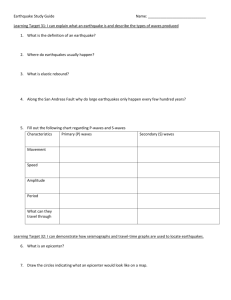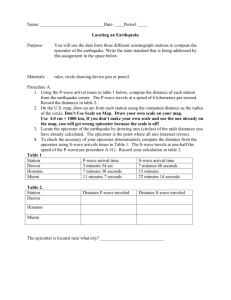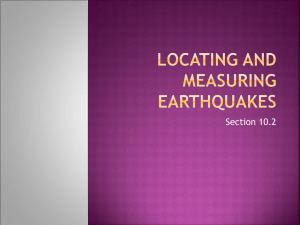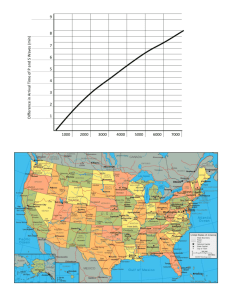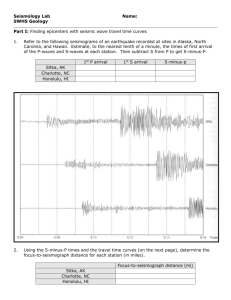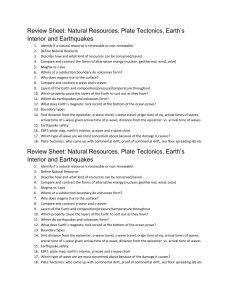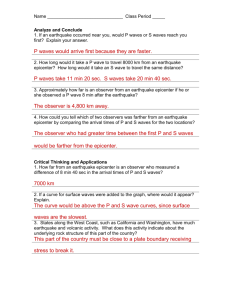Speed of Seismic Waves and Earthquake Epicenter Location
advertisement
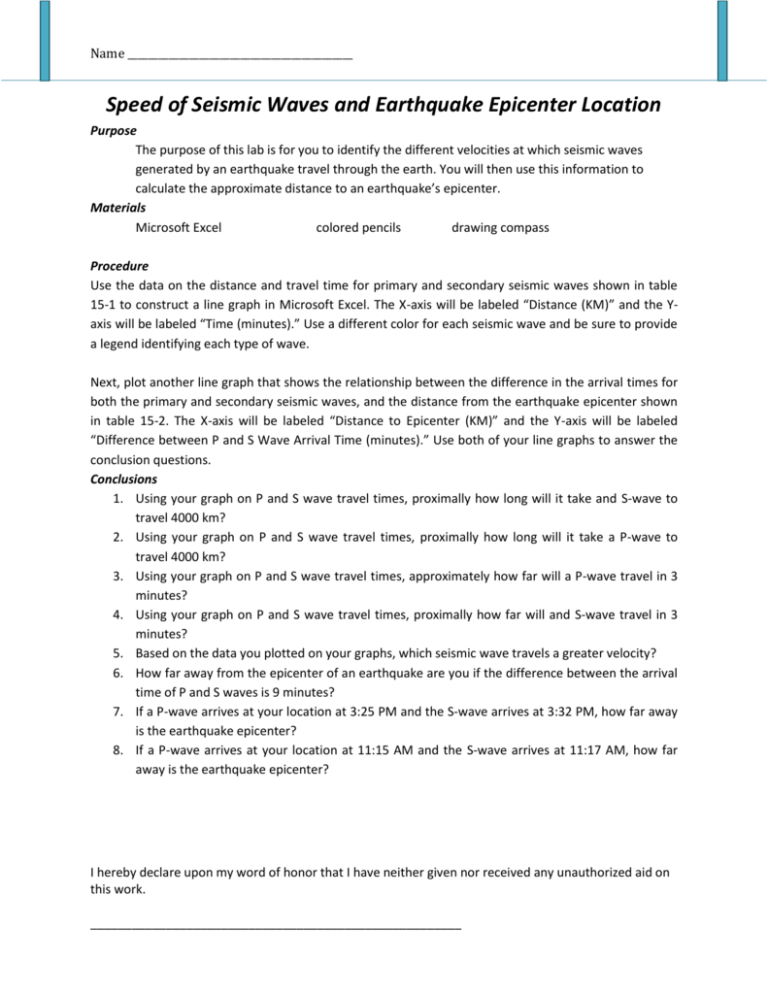
Name ____________________________________________ Speed of Seismic Waves and Earthquake Epicenter Location Purpose The purpose of this lab is for you to identify the different velocities at which seismic waves generated by an earthquake travel through the earth. You will then use this information to calculate the approximate distance to an earthquake’s epicenter. Materials Microsoft Excel colored pencils drawing compass Procedure Use the data on the distance and travel time for primary and secondary seismic waves shown in table 15-1 to construct a line graph in Microsoft Excel. The X-axis will be labeled “Distance (KM)” and the Yaxis will be labeled “Time (minutes).” Use a different color for each seismic wave and be sure to provide a legend identifying each type of wave. Next, plot another line graph that shows the relationship between the difference in the arrival times for both the primary and secondary seismic waves, and the distance from the earthquake epicenter shown in table 15-2. The X-axis will be labeled “Distance to Epicenter (KM)” and the Y-axis will be labeled “Difference between P and S Wave Arrival Time (minutes).” Use both of your line graphs to answer the conclusion questions. Conclusions 1. Using your graph on P and S wave travel times, proximally how long will it take and S-wave to travel 4000 km? 2. Using your graph on P and S wave travel times, proximally how long will it take a P-wave to travel 4000 km? 3. Using your graph on P and S wave travel times, approximately how far will a P-wave travel in 3 minutes? 4. Using your graph on P and S wave travel times, proximally how far will and S-wave travel in 3 minutes? 5. Based on the data you plotted on your graphs, which seismic wave travels a greater velocity? 6. How far away from the epicenter of an earthquake are you if the difference between the arrival time of P and S waves is 9 minutes? 7. If a P-wave arrives at your location at 3:25 PM and the S-wave arrives at 3:32 PM, how far away is the earthquake epicenter? 8. If a P-wave arrives at your location at 11:15 AM and the S-wave arrives at 11:17 AM, how far away is the earthquake epicenter? I hereby declare upon my word of honor that I have neither given nor received any unauthorized aid on this work. ______________________________________________________ Name ____________________________________________ 2013 9. Using your graph on the difference between P and S wave arrival times, the data below, and help from Mr. Mosser, locate the approximate location of an earthquake’s epicenter location on the map in figure 15-1. Use a drawing compass to draw the radius distance from each seismic station where the earthquake occurred. Where the 3 circles converges the approximate location of the earthquake epicenter. a. Seattle, Washington: P-wave arrival time-11:18:00 a.m., S-wave arrival time-11:20:20 a.m. b. Miami, Florida: P-wave arrival time-2:21:20 p.m., S-wave arrival time-2:26:20 p.m. c. Portland, Maine: P-wave arrival time-2:22:00 p.m., S-wave arrival time-2:27:40 p.m. 10. Using the data from question 9, determine at what time the earthquake occurred on the West Coast (P-wave arrival time minus P-wave travel time). Table 15-2: Seismic Waves from Earthquake Epicenter Approximate Distance to Epicenter (km) Difference Between P- and S-Wave Arrival Time (minutes) 0 0 800 1 1200 2 1800 3 2800 4 3200 5 4200 6 5400 7 6400 8 7600 9 8800 10 2


